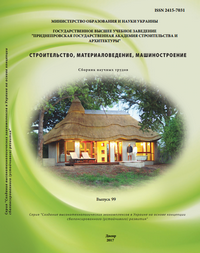Clay soils оf the prydniprovsk region for earthconcrete
Keywords:
clay soils, mineralogical composition of clay soil, plasticity number of clay soil, flowability number of clay soil, cation-exchange capacity of clay soil, earth-concreteAbstract
Abstract. Purpose. Study of the structure, physico-chemical and mechanical properties of various clay soils for erath-concrete industrial production. Methodology. To achieve this goal, the authors have determined the basic physical properties of clay soils in accordance with Ukrainian State Standard 2.1-17-2009. Findings. It is established that in order to obtain high quality concrete products and structures it is necessary to use clay soils of medium dispersity, with low shrinkage and swelling, in the mineralogical composition of which kaolinite predominates, in the absence of organic impurities. If the indices of certain properties are not satisfactory, it can be modified by the introduction of appropriate chemical or mineral additives. It has been established that the investigated clay soil has a plasticity number in the range of 8.8-11.4 and refers to a variety of loams. It was revealed that this kind of soils is best strengthened with cement in an amount of 14-20%, depending on the required strength of the concrete. Originality. The further ideas about the role of various properties of clay soils on the quality of concrete products and structures have been received. Practical value. The basic physical properties of clay soils of the Dnieper region have been determined. The ways of its most effective strengthening by astringents and the manufacture of concrete products and structures have been revealed.
References
Vdovin Ye.A., Mavliyev L.F. Issledovaniye dolgovechnosti modifitsirovannogo tsementogrunta dorozhnogo naznacheniya [The durability analysis of modified soil cement for road purpose]. Promyshlennoye i grazhdanskoye stroitelstvo [Industrial and civil engineering], 2014, no. 11, pp. 76-79.
HBN V. 2.3. – 37641918 – 554:2013. Avtomobilni dorohy. Shary dorozhnoho odiahu z kamianykh materialiv, vidkhodiv promyslovosti i gruntiv, ukriplenykh tsementom. Proektuvannia ta budivnytstvo. [Sectoral construction standards 2.3. – 37641918–554–2013. Motor roads. Road pavement layers of stone materials, industrial waste and soils reinforced with cement. Designing and construction]. Kyiv, Derzhavne ahentstvo avtomobilnykh dorih Ukrainy (Ukravtodor) Publ., 2013. 43 p.
Gorshkov V.S., Timashev V.V., Savelyev V.G. Metody fiziko-khimicheskogo analiza vyazhushchykh veshchestv [Methods of physical-chemical analysis of binding materials]. Moscow, Vysshaya Shkola Publ., 1981. 335 p.
Grishina V. A. Soil-concrete with micro reinforcing mineral and organic additions for construction of rural roads and structure: dis. … candidate of tech. sciences : 05.23.05/ Grishina Viktoriya Aleksandrovna. – Novosibirsk, 2010. – 193 p.
V. T. Trofimov, V. A. Korolev, Ye. A. Voznesenskiy, G. A. Golodkovskaya, Yu. K. Vasilchuk, R. S. Ziangirov : edited by V. T. Trofimov. Gruntovedeniye [Soil science]. Moscow, MGU Publ., 2005. 1024 p.
DSTU B.V. 2.1-17:2009. Osnovy ta pidvalyny budynkiv i sporud. Grunty. Metody laboratornoho vyznachennia fizychnykh vlastyvostei. [State Standard 2.1-17-2009. Bases and foundations of buildings and structures. Soils. Laboratory methods for determination of physical characteristics]. Kyiv, Minrehionbud Ukrainy Publ., 2010. 32 p.
DSTU B.V. 2.1-2-96 (HOST 25100-95). Osnovy ta pidvalyny budynkiv i sporud. Grunty. Klasyfikatsiia. [State Standard 2.1-2-96. Bases and foundations of buildings and structures. Soils. Classification]. Kyiv, Derzhavnyi komitet Ukrainy u spravakh mistobuduvannia i arkhitektury Publ., 1997. 47 p.
Knatko V. M. Ukrepleniye dispersnykh gruntov putem sinteza neorganicheskikh vyazhushchikh [Disperse soils stabilization by synthesis of inorganic matter]. Leningrad, Leningrad University Publ., 1989. 272 p.
Minke G. Glinobeton i yego primeneniye [The clay-containing concrete and its application]. Kaliningrad, Yantarnyy skaz Publ., 2004. 232 p.
Savytskyi M.V., Yelisieieva M.O., Kuzmin H.I., Novichenko N.V., Bardakh Ye.A., Yevsieiev Ye.O. Prochnost gruntobetonov v zavisimosti ot sostava smesi [Soil-concretes strength depending on the proportion of mixture]. Stroitelstvo, materilovedeniye, mashynostroyeniye [Construction, materials, mechanical engineering], 2015, issue 82, pp. 179-186.
Savytskyi M.V., Storozhuk M.A. Effektivnaya tekhnologiya proizvodstva samana [Effektive technology of adobe]. Visnyk Prydniprovskoi derzhavnoi akademii budivnytstva ta arkhitektury [Bulletin of Prydniproprovsk State Academy of Civil Engineering and Architecture], 2013, issue 8, pp. 4-9.
Bezruk V.M., Guryachkov I.L, Lukanina T.M., Agapova R.A. Ukreplennyye grunty. (Svoystva i primeneniye v dorozhnom i aerodromnom stroitelstve) [Stabilized soils. (Properties and application in the road and airfield construction)]. – Moscow, Transport Publ., 1982. 231 p.
Shlegel I.F. O stroyenii glin [On the structure of clay] Stroitelnyye materialy [Building materials], 2013, no. 6, pp. 56.
Berge B. The ecology of building materials. Translated by C. Butters and F. Henley. – Second edition. – Oxford: Architectural Press Publ., 2009. – 427 p.
Lekha B.M., Goutham S., Shankar A.U.R. Evaluation of lateritic soil stabilized with Arecanut coir for low volume pavements. Transportation Geotechnics, 2015, no. 2. doi: 10.1016/j.trgeo.2014.09.001.
Downloads
Published
Issue
Section
License
Редакція Видання категорично засуджує прояви плагіату в статтях та вживає всіх можливих заходів для його недопущення. Плагіат розглядається як форма порушення авторських прав і наукової етики.
При виявлені у статті більш ніж 25% запозиченого тексту без відповідних посилань та використання лапок, стаття кваліфікується як така, що містить плагіат. У цьому випадку стаття більше не розглядається редакцією, а автор отримує перше попередження.
Автори, в статтях яких повторно виявлено плагіат, не зможуть публікуватися в усіх журналах Видавництва ДВНЗ «Придніпровська державна академія будівництва та архітектури».
Автори, які публікуються у цьому журналі, погоджуються з наступними умовами:
- Автори залишають за собою право на авторство своєї роботи та передають журналу право першої публікації цієї роботи на умовах ліцензії Creative Commons Attribution License, котра дозволяє іншим особам вільно розповсюджувати опубліковану роботу з обов'язковим посиланням на авторів оригінальної роботи та першу публікацію роботи у цьому журналі.
- Автори мають право укладати самостійні додаткові угоди щодо неексклюзивного розповсюдження роботи у тому вигляді, в якому вона була опублікована цим журналом (наприклад, розміщувати роботу в електронному сховищі установи або публікувати у складі монографії), за умови збереження посилання на першу публікацію роботи у цьому журналі.
- Політика журналу дозволяє і заохочує розміщення авторами в мережі Інтернет (наприклад, у сховищах установ або на особистих веб-сайтах) рукопису роботи, як до подання цього рукопису до редакції, так і під час його редакційного опрацювання, оскільки це сприяє виникненню продуктивної наукової дискусії та позитивно позначається на оперативності та динаміці цитування опублікованої роботи (див. The Effect of Open Access).

